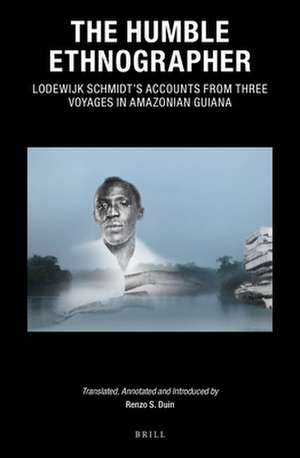The Humble Ethnographer: Lodewijk Schmidt's Accounts from Three Voyages in Amazonian Guiana: Caribbean Series, cartea 38
Autor Renzo S. Duinen Limba Engleză Hardback – 23 sep 2020
Lodewijk J. Schmidt (1898-1992) Saramaka from Gansee (modern Saamaka spelling: Ganzë; pronounced Ganzè), upper Suriname river, Suriname, South America. The Saramaka are one of the largest African Diaspora communities in Suriname. He was educated by the Herrnhutters in the school of the Moravian Church, and during the mid-twentieth century he took part in several momentous expeditions, such as the 1935-38 Border Expedition between Suriname and Brazil. The present work is the annotated translation of his accounts of a tri-partite expedition conducted between 1940 and 1942 at and across the southern border of Suriname.
Renzo S. Duin (1974) obtained a PhD in Anthropology from the University of Florida (USA). Between 1996 and 2019 he conducted over 40 months of fieldwork in the Guianas (Suriname, French Guiana, and Guyana). His research and publications cover a broad range of topics: socio-political landscape studies; material culture; intangible heritage; social memory; oral history; identity; ethno-astronomy; historical ecology; decolonization; and the intertwining nature of these topics, and as such offers an alternative to the twentieth century model of tropical forest cultures in Amazonia.
Preț: 704.36 lei
Preț vechi: 858.97 lei
-18% Nou
Puncte Express: 1057
Preț estimativ în valută:
134.77€ • 140.73$ • 111.29£
134.77€ • 140.73$ • 111.29£
Carte indisponibilă temporar
Doresc să fiu notificat când acest titlu va fi disponibil:
Se trimite...
Preluare comenzi: 021 569.72.76
Specificații
ISBN-13: 9789004429710
ISBN-10: 9004429719
Dimensiuni: 155 x 235 mm
Greutate: 0 kg
Editura: Brill
Colecția Brill
Seria Caribbean Series
ISBN-10: 9004429719
Dimensiuni: 155 x 235 mm
Greutate: 0 kg
Editura: Brill
Colecția Brill
Seria Caribbean Series
Notă biografică
Renzo Duin (1974) obtained a PhD in Anthropology from the University of Florida (USA). His dissertation looks at on the socio-political landscapes in the Eastern Guiana Highlands, northern Amazonia. His research and publications cover a broad range topics ranging from material culture, intangible heritage, social memory, oral history, identity, ethno-astronomy, historical ecology, decolonization, and the intertwining nature of these topics. He has held research and teaching positions at the University of Florida (USA) and Leiden University (the Netherlands), as well as research positions at Oxford University (UK) and University College London (UK). In the latter capacity, in which position he led and participated in various international research projects. He has organized and participated in several international symposia and exhibitions. Between 1996 and 2018 he conducted over 40 months of fieldwork in the Guianas (Suriname, French Guiana, and Guyana) consisting of 17 fieldtrip ranging from 1 to 6 months.
Cuprins
List of Figures and Tables
About the Translator and Editor of the Present Volume
Book Summary
1 Definitions and Aspirations
2 The Significance of Lodewijk Schmidt’s Accounts to Anthropology Today
3 The Politics of Authorship and Circumstances of First Publication
4 Mapping the Unknown (or: An Audacious Colonial Endeavor)
5 Notes on the Translation
1 A Short Note on Indigenous Peoples and African Diaspora Communities
2 Some Surinamese Socio-political Concepts
3 Some Typical Surinamese Terms
4 A Short Note on Geographic Names
6 Introduction to the Original Publication
7 Notes on Wayana and Trio Demographics and Settlement Names
8 Account of the First Expedition
9 Account of the Second Expedition
10 Account of the Third Expedition
11 General Comments
12 Quantitative and Qualitative Analysis of the List of Names of Inhabitants
13 The Inhabitants of the Wayana Villages on the Litani and Mapahoni Recorded by Lodewijk Schmidt between November 1940 and January 1941
14 The Inhabitants of the Trio and Wayana Villages in South Suriname and in North Brazil Recorded Between November 1940 and March 1942
15 The Inhabitants of the Wayana Villages on the Jari and Paru de l’Este Recorded Between November 1940 and January 1941
16 Afterthought
Bibliography
Index
About the Translator and Editor of the Present Volume
Book Summary
Part 1: Introduction and Context
1 Definitions and Aspirations
2 The Significance of Lodewijk Schmidt’s Accounts to Anthropology Today
3 The Politics of Authorship and Circumstances of First Publication
4 Mapping the Unknown (or: An Audacious Colonial Endeavor)
5 Notes on the Translation
1 A Short Note on Indigenous Peoples and African Diaspora Communities
2 Some Surinamese Socio-political Concepts
3 Some Typical Surinamese Terms
4 A Short Note on Geographic Names
Part 2: Ethnographic Accounts from Three Voyages in Amazonian Guiana
6 Introduction to the Original Publication
7 Notes on Wayana and Trio Demographics and Settlement Names
8 Account of the First Expedition
9 Account of the Second Expedition
10 Account of the Third Expedition
Part 3: The People, and other Important Things
11 General Comments
12 Quantitative and Qualitative Analysis of the List of Names of Inhabitants
13 The Inhabitants of the Wayana Villages on the Litani and Mapahoni Recorded by Lodewijk Schmidt between November 1940 and January 1941
14 The Inhabitants of the Trio and Wayana Villages in South Suriname and in North Brazil Recorded Between November 1940 and March 1942
15 The Inhabitants of the Wayana Villages on the Jari and Paru de l’Este Recorded Between November 1940 and January 1941
16 Afterthought
Bibliography
Index












